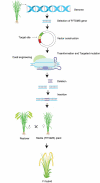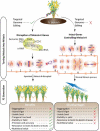Apomixis and strategies to induce apomixis to preserve hybrid vigor for multiple generations
- PMID: 32877304
- PMCID: PMC7553744
- DOI: 10.1080/21645698.2020.1808423
Apomixis and strategies to induce apomixis to preserve hybrid vigor for multiple generations
Abstract
Hybrid seeds of several important crops with supreme qualities including yield, biotic and abiotic stress tolerance have been cultivated for decades. Thus far, a major challenge with hybrid seeds is that they do not have the ability to produce plants with the same qualities over subsequent generations. Apomixis, an asexual mode of reproduction by avoiding meiosis, exists naturally in flowering plants, and ultimately leads to seed production. Apomixis has the potential to preserve hybrid vigor for multiple generations in economically important plant genotypes. The evolution and genetics of asexual seed production are unclear, and much more effort will be required to determine the genetic architecture of this phenomenon. To fix hybrid vigor, synthetic apomixis has been suggested. The development of MiMe (mitosis instead of meiosis) genotypes has been utilized for clonal gamete production. However, the identification and parental origin of genes responsible for synthetic apomixis are little known and need further clarification. Genome modifications utilizing genome editing technologies (GETs), such as clustered regularly interspaced short palindromic repeats (CRISPR)/CRISPR-associated protein (cas), a reverse genetics tool, have paved the way toward the utilization of emerging technologies in plant molecular biology. Over the last decade, several genes in important crops have been successfully edited. The vast availability of GETs has made functional genomics studies easy to conduct in crops important for food security. Disruption in the expression of genes specific to egg cell MATRILINEAL (MTL) through the CRISPR/Cas genome editing system promotes the induction of haploid seed, whereas triple knockout of the Baby Boom (BBM) genes BBM1, BBM2, and BBM3 cause embryo arrest and abortion, which can be fully rescued by male-transmitted BBM1. The establishment of synthetic apomixis by engineering the MiMe genotype by genome editing of BBM1 expression or disruption of MTL leads to clonal seed production and heritability for multiple generations. In the present review, we discuss current developments related to the use of CRISPR/Cas technology in plants and the possibility of promoting apomixis in crops to preserve hybrid vigor. In addition, genetics, evolution, epigenetic modifications, and strategies for MiMe genotype development are discussed in detail.
Keywords: CRISPR/CAS system; Hybrid vigor; apomixis; flowering plants.
Figures



References
-
- Sheng Z, Wei X, Shao G, Chen M, Song J, Tang S, Luo J, Hu Y, Hu P, Chen L.. Genetic analysis and fine mapping of tms9, a novel thermosensitive genic male‐sterile gene in rice (Oryza sativa L.). Plant Breed. 2013;132:159–64.
Publication types
MeSH terms
LinkOut - more resources
Full Text Sources
